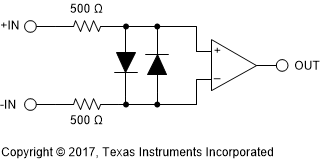JAJSEA5D December 2017 – October 2019 OPA207
PRODUCTION DATA.
- 1 特長
- 2 アプリケーション
- 3 概要
- 4 改訂履歴
- 5 Pin Configuration and Functions
- 6 Specifications
- 7 Detailed Description
- 8 Application and Implementation
- 9 Power Supply Recommendations
- 10Layout
- 11デバイスおよびドキュメントのサポート
- 12メカニカル、パッケージ、および注文情報
パッケージ・オプション
メカニカル・データ(パッケージ|ピン)
サーマルパッド・メカニカル・データ
発注情報
7.3.2 Input Protection
The input stage of the OPA207 is internally protected with resistors in series with diode clamps as shown in Figure 36. The inputs can withstand ±10 V differential inputs without damage and the maximum input current should be limited to 10 mA or less.. The protection diodes conduct current when the inputs are over-driven such as when the opamp output is slewing. This may disturb the slewing behavior of unity-gain follower applications, but will not damage the operational amplifier.
 Figure 36. Simplified OPA207 Input Protection Circuit
Figure 36. Simplified OPA207 Input Protection Circuit